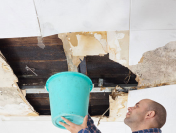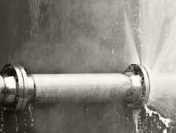Bitter cold weather brings the risk of frozen pipes in homes and apartments. Frozen pipes are not only inconvenient, they can lead to disaster if the pipes burst and spray icy cold water all over walls, floors and furnishings. The good news is that not every frozen pipe will rupture and leak. In most situations, homeowners can safely thaw frozen pipes themselves. Here is a step-by-step guideline for defrosting frozen pipes and suggestions on how to prevent your pipes from freezing the next time there’s a deep freeze.
What Causes Pipes to Freeze?
Very cold winter weather or a drop in indoor temperature due to a furnace failure or power outage can cause pipes to freeze. Because water expands when it freezes, it can cause metal or plastic pipes to burst. Some pipes are more at risk of freezing than others, including pipes in unheated areas like basements, garages, attics and crawlspaces; pipes located in exterior walls; pipes in under-insulated walls; and any outdoor plumbing, such as water spigots and sprinkler systems.
How Do You Know You Have Frozen Pipes?
Homeowners usually know that they have a frozen pipe if nothing comes out when they turn on the water tap, or the washing machine fails to fill, or the toilet tank doesn’t replenish after flushing. Sometimes there is a visible sign that a pipe is frozen, such as a bulge or frosty coating.
How to Locate a Frozen Pipe
It’s important to take immediate action when you realize that you have a frozen pipe so you can remedy the situation before the pipe bursts. To locate where the frozen pipe is:
Begin by turning off the water main supply to prevent water from gushing out once the pipe is thawed.
- Next, open all of the taps around the house.
- If water isnt running anywhere in the house, a pipe near the water meter may be frozen. Touch the water meter and the adjacent exposed pipes. If they are very cold, they are probably frozen.
- If water runs in only one part of the house, a pipe in an outside wall or uninsulated crawl space is probably frozen. Open kitchen and bathroom sink cabinets to allow warm air from the house to warm the pipes.
Steps to Defrost a Frozen Pipe
 1) Open faucets: Once you have located the frozen pipe, open the affected faucet all the way. Next, open all of the other hot water faucets in the house. When the water is flowing in the affected pipe, close all the faucets to a trickle. Do not close the affected faucet until the pipe is completely thawed and the water is flowing freely.
1) Open faucets: Once you have located the frozen pipe, open the affected faucet all the way. Next, open all of the other hot water faucets in the house. When the water is flowing in the affected pipe, close all the faucets to a trickle. Do not close the affected faucet until the pipe is completely thawed and the water is flowing freely.
2) Heat frozen pipes: The safest and neatest thawing methods involve a gentle heat source such as a hair dryer, heat lamp or household iron. Start from the interior faucet end of the pipe, and work your way toward colder end of the pipe to keep steam from being trapped by ice and bursting the pipe.
You can also pouring boiling water over rags or towels and wrap them around a frozen pipe, however, this method is messy. Never pour boiling water directly onto a frozen pipe. Wrapping the affected area with thermostatically controlled heat tape is another effective way to quickly thaw frozen pipes. Note: Never use a propane torch or other open flame to thaw a pipe because it can heat the pipe too quickly and cause it to explode.
3) Check for leaks: With the faucet open, you will see when the ice in the pipe has melted because the water will begin to flow. After pipes have thawed, turn off all water to faucets and the icemaker and monitor the water meter for any unseen leaks.
4) If a pipe bursts: If you are unable to thaw a frozen pipe and it bursts, your best bet is to call a professional plumber. Ruptured pipes are hard to repair. Be sure to first shut off water at the main valve. If the break is in a hot water pipe, close the the valve on top of the water heater.
How to Prevent Frozen Pipes
 Keep your thermostat set at a consistent temperature both day and night.
Keep your thermostat set at a consistent temperature both day and night.- If you are going away, maintain an interior temperature above 55°F. (In an unoccupied house, you can shut down the heating system as long as you completely drain the plumbing system.)
- Invest in a call-out freeze alarm. A call-out freeze alarm is a device that monitors the indoor temperature and alerts you when the temperature drops below a certain level (typically around 45° F) so you can intervene before the pipes freeze and burst.
- Seal all holes and cracks in outside walls.
- Pipes leading to the exterior should be shut off and drained at the start of the winter.
- During cold snaps, open cabinet doors under kitchen and bathroom sinks to allow the warmer air of the room to circulate around the pipes.
- Insulate all pipes in unheated or uninsulated areas using a pipe sleeve UL-listed heat tape, or a heat cable, all of which can be purchased at a building supply retailer.
- If you are away for extended periods of time or want to protect a second home, consider installing a whole house water shutoff valve that automatically turns off the water main when a plumbing leak is detected to prevent damage from floods caused by frozen pipes that burst or other plumbing problems.






Ken Adams
Thanks so much for sharing this info. Frozen pipes can cause such a headache for homeowners. Great tips to help them prepare and avoid costly damage and repairs. Franklin Plumbing SC